1 Introduction
When students study abroad, they strongly attach to their host country. They keep personal ties and report feeling more fond of the visited country (King and Ruiz-Gelices, 2003). Upon return, the majority of exchange students claim that their knowledge about the host country’s culture has improved. Moreover, former international students reap professional benefits in the long run. While most students utilize their gained language proficiency at work, others even revisit their former host country for business.
Surveying University of Sussex students on their year abroad King and Ruiz-Gelices’ (2003) show how strongly international students connect with their study abroad destination. These connections can prove useful, especially for building business relationships across countries. Indeed, searching for business partners is one of the most important obstacles to cross-border trade (Carballo et al., 2022). The information immigrants acquire about the host country’s culture and customs is highly valuable to international trade (Gould, 1994). For industrialized countries, this contributes around 6% of overall trade costs (Anderson and Van Wincoop, 2004).
Despite a growing body of research on immigration and international trade, the literature has barely studied international students’ trade outcomes. There are reasons to think that international students may have a distinctly different effect from other migrants. First, UNESCO Institute for Statistics (n.d.) defines internationally mobile students as individuals who cross a border to study, as opposed to other immigrants that may migrate specifically for work. King and Ruiz-Gelices (2003) further find that the students’ motivation to study abroad lies predominantly with cultural interests, including acquiring language skills, and personal growth.
Second, students do not seem to stay in the host country. The Organization for Economic Cooperation and Development estimates that for several of its members, only between 15% and 35% of international students stay in the host country to apply for work or other permits (OECD, 2011). This short term stay could potentially lead to different trade outcomes compared with long term immigrants, especially because immigrants’ impact on trade grows with their duration of stay (Gould, 1994). This suggests that to bridge informational frictions, migrants need to learn about the host country. Can international students acquire this knowledge during their short stay?
Finally, an immigrant who travels for work may be more experienced on the job than a recent graduate and thus may present a better candidate for strengthening business relations. Anders (2021) reports that over 30% of entry-level job openings posted between 2017 and 2021 on LinkedIn required years of prior work experience. While this rate ranges from 8.2% in retail to 60.3% in information technology, it makes entering the workforce particularly difficult for newcomers in some fields.
Do international students have the ability and resources to use their knowledge about their host country for business? Many scholars have explored similar questions. Khan and Bin (2022) show that international student inflows to Chinese provinces go hand-in-hand with a rise in these provinces’ trade. This phenomenon is greater in more developed destinations. However, examining this relationship on a province-year-level makes accounting for origin heterogeneity or product differentiation impossible.
Murat (2014, 2018) shows that international student migration does in fact have trade-inducing effects. I contribute to the literature by building on her work in four key ways: using a significantly broader set of countries, comparing students to the average migrant, examining contract intensity, and, most importantly, ruling out alternative explanations for my findings. I find that students have a greater impact on trade than the average migrant.
I use panel data on 34 host countries (mostly OECD) and 172 origin countries from 2000 to 2018. I observe that increasing the share of international students in total immigration is associated with a rise in the host’s total imports from the student’s origin, and its exports in low relationship-specific products to the origin. This suggests that international students induce trade and mitigate information frictions differently compared to other immigrants. Disaggregating trade into homogeneous and differentiated products, as well as contract intensities, points towards a student effect with only a limited capacity to overcome some informational barriers. Surprisingly, this is not true for students from non-OECD countries where cultural barriers are particularly high. These findings underline the obstacles and advantages some networks (such as students and recent graduates) face, an issue barely discussed in the existing literature.
I proceed as follows: Section 2 discusses the related literature. Section 3 sets up the econometric model
and describes the data I use. Section 4 presents and discusses the results. Section 5 concludes and
proposes avenues for further analysis.
2 International students’ trade effects
This paper is related to the broader trade and migration literature and more specifically to studies targeting temporary and high-skilled migrants. Essentially, previous findings about student migration point in a similar direction as those of permanent migration. Two channels are responsible for the immigrants’ trade effect: the immigrants’demand for their origin countries’products (preference channel) and reduced information barriers (information channel). While the preference channel affects the host countries’ imports, that is, the country the immigrant has moved to, the information channel can increase both imports and exports because it lowers transaction costs of trade by alleviating communication and institutional barriers between foreign countries (Gould, 1994).
Information barriers, which migrants can reduce, are a relevant deterrent to bilateral trade (Anderson
and Van Wincoop, 2004). In theory, students can facilitate trade via both channels, but since they tend to leave the host country, the preference channel would affect the origin’s imports rather than exports.1Note that since students presumably have limited income while overseas, their impact on host imports via the preference channel while studying is likely negligible. That is, once students have left the host country, the host’s exports can include former students’ consumption while back at their origin. Even if students choose to live in a country different from their origin and host after graduation, exports can still be driven by increased consumption, but by a third country. The preference channel only impacts the host’s imports so long as the international student stays in the host country, which only a minority of students seem to do (OECD, 2011).
However, there are reasons to believe that the underlying mechanisms depend on the immigrants’ connectedness to their origin country (and host country), their skill or education level, and their occupation. How connected they are to their origin country can be attributed to their duration of stay at the host. Jansen and Piermartini (2009) argue that higher trade outcomes due to temporary immigration can be the result of immigrants’ high knowledge of current customs in the origin country. While this can prevent them from gaining a deep knowledge about the host country’s culture and customs, short stays per se will not determine whether a migrant can effectively reduce informational barriers.
Instead, tourism and business travel can stimulate trade without visitors settling abroad (e.g., Santana Gallego et al. (2016) and Startz (2016)). Face-to-face interactions can especially contribute to bilateral trade. To explore the effect of air connectivity, Wang et al. (2021) employ an instrumental variable that captures third-country layover capacity. This shows that in-person contact significantly boosts information-intensive trade.
High-skilled immigrants are specific drivers of the trade-increasing effects of immigration (e.g., Egger et al. (2020); Felbermayr and Jung (2009); Felbermayr and Toubal (2012)). Highly educated migrants who hold managing roles in business provide even more preferable preconditions to induce trade (Aleksynska and Peri, 2014). Managers can steer a firm into the export market. This is more likely for managers with more international experience and market knowledge (Mion and Opromolla, 2014).
In contrast to other types of immigrants, international students present a unique case: they are highly skilled, and their stay is typically bound to an academic institution where they form international connections (Munoz et al., 2015; OECD, 2011). This, however, must be viewed in light of a recent graduate’s young age, something that Hatzigeorgiou and Lodefalk (2015) find inhibits their integration with labor markets, and thus their effect on trade.
International students typically form social connections with other international students and host nationals during their stay abroad (Munoz et al., 2015). The formation of social connections matters particularly for international trade (Bailey et al., 2021). A question rarely posed is how friendships play a role in immigrants’ trade effects, despite the fact that research into how trust facilitates trade dates back to Greif’s (1989; 1993) studies on the Maghribi traders.
If student migration leads to relationships and trust between the participating parties, this should enhance their connectedness even after leaving the host country. In fact, student networks are profitable on the job and finding one in the first place (Cohen et al., 2008; Machado et al., 2022). This is something that Murat (2014, 2018) examines. Both studies find positive associations with trade. Both studies find positive associations with trade. I contribute to this discussion by first, expanding the country coverage, allowing me to dig deeper into the role of cultural differences. Second, I examine additional measures of product-level information barriers. Finally, I investigate student mobility from a different angle. That is, I investigate the potential mechanisms underlying a trade effect while attempting to disentangle the two main underlying channels.
I also contribute to the broader literature on trade and immigration. For example, Girma and Yu (2002) and Dunlevy (2006) find that the impact of immigration is higher for countries with dissimilar institutions and cultures. I find a comparable effect for the role of students. Other research exploits the importance of information required for a good to be traded. The more information frictions a product has to go through, the more it can benefit from immigrants providing required information. This means that the trade of differentiated goods benefits more from immigration than does the trade of homogeneous goods (Rauch and Trindade, 2002). This is confirmed by Murat (2018) for international student migration from Latin America. Moreover, Wei et al. (2020) find that inflows of international students boost China’s lower technological goods exports, while student outflows stimulate higher technological goods exports. I expand on this by using both Rauch’s (1999) classification, and further, Nunn’s (2007) classification, which considers the contract intensity of a good.
In summary, the existing literature suggests that international student migration can play a role in immigration driving trade. I anticipate that this impact is greatest when cultural barriers are larger. One might also expect that students are especially important in the trade of products for which information is important, although the inexperience of recent graduates may limit this effect. I test these hypotheses using a broader data set than has been used to this point.
3 Econometric methodology and data
In the following section, I lay out my econometric model and show descriptive statistics of the data with particular attention to student data.
3.1 Econometric model
My econometric model is the now standard gravity model of trade. Specifically, I model exports from host country to origin country
in year
as a function of, among other things, the international students sent from
to
. My baseline specification employs country-pair specific covariates common to the literature,
, and several fixed effects to estimate the effect of international students on trade. Following Aleksynska and Peri (2014), I control for total immigration and the share of students in total immigration.2Aleksynska and Peri (2014) measure high-skilled migrants in the same manner. This mitigates omitted variable bias due to confounding factors because migrants from one country seem to attract international students from the same country (Murat, 2014, 2018; Perkins
and Neumayer, 2014). This gives the following exports equation (the imports equation follows the
same structure):
(1)
is total immigration by country of origin in a host country at time
. The
is the percent share of international students in this total.3For brevity, I will refer to
and
hereafter. The control variables,
, include the time-invariant variables
,
,
, and
, as well as the time-variant variable
. Note that except for distance, these are all dummy variables. Country-year specific variables such as GDP or population are captured by country-year fixed effects. These also capture multilateral resistance (Anderson and Van Wincoop, 2003). In the disaggregated trade regressions, I additionally include HS 6-digit fixed effects. My standard errors are clustered by country-pair.
The favoured specification additionally controls for country-pair fixed effects. Although could confound the impact of the
on trade, by construction, it is a function of the variable of interest and something that that Angrist and Pischke (2009) would call a “bad control,” which introduces selection bias. Therefore, I leave out this variable in the chosen specification with country-pair fixed effects as these absorb most of its variation.4For a comparison, its between variation has a standard deviation of about 3 and within variation around 0.3. See Appendix Table 15 for overall summary statistics.
Moreover, in the estimating equation, I use the values of the student share (and total immigration) due to endogeneity concerns. The endogeneity stems from omitted variables that affect students’ migration preferences (Beine et al., 2016). Therefore, I follow Murat (2018) in lagging both variables by four years to mitigate reverse causality. Lagging these by the duration of the average university degree leads to a number of international students having finished their degree at the time I estimate their effect.
(2)
As to not lose import or export values, I add the value one to the trade value in Equation 1. However,
to deal with both zeros in the value of exports and heteroskedasticity, I use Silva and Tenreyro’s (2006)
Poisson pseudo-maximum-likelihood (PPML) estimator in my preferred gravity-model specification,
Equation 2. If the variable of interest, student migration, is zero in a given oht triad, then this also
becomes undefined. Therefore, so as not to lose those observations, I add one student to each triad’s
total student number and divide by total immigration in before logging the
.
Similarly, I use the logarithm of plus one to tackle this same problem of potential
sample selection where necessary.
3.2 Data and descriptive statistics
For my empirical analysis, I consider 34 host and 172 origin countries from 2000 to 2018.5I start in 2000 because it is the year when student data on the major hosts (e.g., the USA) becomes available. Due to end of data truncation, I end my sample in the year 2018 (compare Appendix Figure 5). Depending on lagged variables, I end up with a fifteen year time period.
International students data The data on the number of internationally mobile students by country of origin are from UNESCO Institute for Statistics (UIS), which start in 1998 and are updated annually. UNESCO Institute for Statistics (n.d.) describes international students as students who left their origin country to obtain tertiary education from another country. Thus, by definition the number of inbound students excludes all other reasons for immigration (e.g., work).
As expected, there are a number of country pair-years with no or very little migration. Even when aggregating across years there is a skewed distribution with some countries attracting students from nearly everywhere and others hosting very few students.6As noted above, the fact that immigrants generally choose their host country has brought attention to a possible endogeneity problem in trade regressions on immigration (Beine et al., 2016). The main hosts of international students are the United States, the United Kingdom, and Australia (Appendix Table 9 shows a list of the top five hosts). From 2000 to 2018, Canada emerged to become one of the favorite destinations relative to its own population. This pattern suggests a strong global preference for English-speaking hosts (captured by the fixed effects and common language dummy). Figures 1 and 2 show this development over the 18-year time frame.7Made with Natural Earth. Free vector and raster map data @ naturalearthdata.com. Data on population are from The World Bank’s World Development Indicators.
Figure 1. Number of Students Relative to Population by Host Countries in 2000
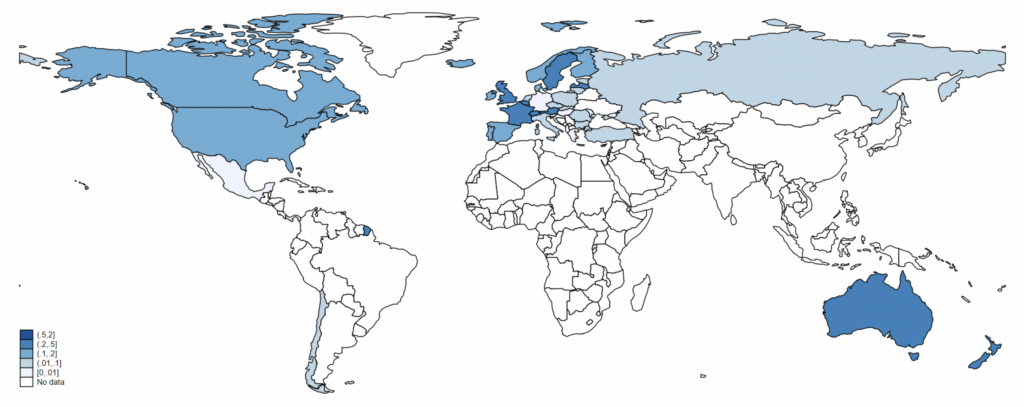
Figure 2. Number of Students Relative to Population by Host Countries in 2018
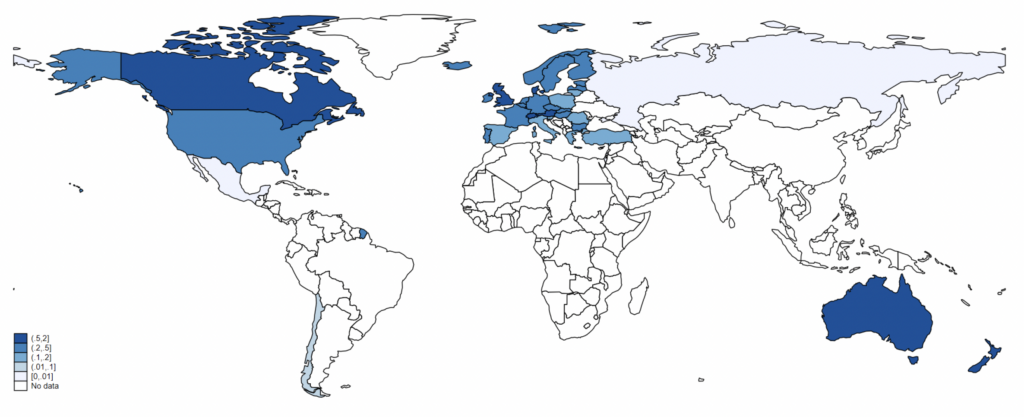
On the origin side of the cross-border movement, there are no countries that never send any students to another country. In terms of numbers, Chinese and Indian students move across borders for foreign education the most, suggesting that large populations send more students (a factor again captured by the country-year fixed effects). As mentioned above, there is a clear indication that most student migration goes to OECD countries. In comparison, on average, only 42 students study yearly in a non OECD member state between 2000 and 2018. Out of those 42 students, 22 come from an OECD member state. Nevertheless, there is an increase in international students every year. Somewhat unexpectedly, the within country-pair variation in the number of international students is high. For example, the standard deviation of Chinese students in the United States is around 99,000 students.
Immigration data Total immigration is the stock of the foreign born population by country of birth (origin) in a given host. The data are retrieved from the OECD (2020) International Migration database for immigrants in OECD countries.8The OECD (2020) International Migration database also provides data on the stock of the foreign population by nationality. The difference between both measures is that the stock of foreign born immigrants is intended to refer only to first-generation immigrants, whereas foreign population potentially captures more generations of migrants. I use the stock of foreign born immigrants because the length of their stay decreases the immigrants’ returns to bilateral trade (Herander and Saavedra, 2005). If I used the stock of the foreign population, I would also consider the immigrants’ descendants that grew up in the host country. Whether they still demand origin country products and have knowledge about origin country institutions is questionable. To this, I add the above-discussed number of students.9OECD’s International Migration Database consists of data from population registers and censuses, residence permits, and labor force surveys. Given this method of collection and the short stay of international students, there is reason to expect that they are underrepresented in the OECD data. The OECD (2022) summarises the definitions applied in their reports. Thus, the variable includes both students and non-students, with
controlling for relative share of students in the mix. One limitation of the immigration data is that they are essentially limited to OECD hosts.
Figure 3. Recreated Relationship-specificity Parameter in Exports (left) and Imports (right)

Trade data The dependent variable, exports or imports between country-pairs by year, is measured in US dollars trade value and retrieved from the UN’s (2020) Comtrade Database in HS96 nomenclature for the years 2000 to 2018. Exports are measured as what the host sends to a student’s origin while imports are what the origin sends to the host. When operating at the product-level, I use the trade at the 6-digit product level. The skewed distribution of the data and large number of zeros, especially at the product level, motivates my use of the PPML estimator.
In addition to trade values, for my product-level analysis, I employ Rauch’s (1999) product classification that classifies 4-digit SITC rev. 2 commodities into goods traded on an organized exchange, reference priced and differentiated products. Additionally, I used Nunn’s (2007) conservative
contract-intensity measure that makes use of Rauch’s (1999) product classification and retrieves a variable for intermediate input relationship-specificity, .10For a detailed description on the procedure of mapping these trade classifications HS96, see Appendix. Thus, it measures an exported product’s contract intensity for a given exporting country and year. This relationship-specificity parameter,
, is shown in Figure 3 for both, exports and imports. Most relationship-specificity values are at the extremes with most inputs being either differentiated or homogeneous.
Other The data on distance, common official language, contiguity, and colonial history are from Centre d’Études Prospectives et d’Informations Internationales’ (CEPII) GeoDist and Language datasets (see Mayer and Zignago (2011); Melitz and Toubal (2014)). I use the distance in kilometres between the most populated cities as the distance between the trading countries. equals one if a country-pair have ever been in a colonial relationship. Trade agreements data are from Mario Larch’s Regional Trade Agreements Database from Egger and Larch (2008).
4 Regression Analysis
4.1 Baseline model
My baseline regression results are in Table 1.11Table 10 provides the respective OLS regressions as in Equation 1. Focusing on exports in Columns (1) through (4), as expected, the more distant the country-pair, the lower the exports. In a similar sense, regional trade agreements and contiguity increase trade. However, colonial history and common official language appear to negatively associate with exports and imports. Once country-pair fixed effects are controlled
for, any additional time-invariant bilateral confounders are accounted for. A specification which includes such fixed effects is thus preferred.
Turning to the migration variables, total immigration has a significantly positive effect on exports. Including country-pair fixed effects, its coefficient becomes insignificant for imports but still yields the expected positive and significant coefficient for exports: a 10% increase in total immigrants is associated with a 0.4% increase in exports from the host to the origin country (see Column (3)). This result is smaller than some others in the literature but still in the expected range. For example, Head and Ries (1998) find an export elasticity of 0.1 for Canada and Dunlevy (2006) finds American export elasticity to lie between 0.29 (without fixed effects) and 0.47 (with fixed effects). As in Murat (2014, 2018), I find a positive association between the share of students and exports. Since this holds the number of total immigrants (student and non-student) constant, this means that students have a larger effect on exports than the average migrant.
In Columns (5) through (8), I turn to imports, that is, what the host imports from the origin. On the whole, the results are comparable to exports, including the total immigration variable (without country-pair fixed effects). A notable exception is the coefficient which, unlike for exports (see Column (4)), is significant in Column (8).12This association holds even when controlling for the third lag in the international student share or total immigration (see Appendix, Table 12 and Table 11 for exports). In this last, and favored specification, I make two changes. First, I refrain from logging the
variable. In the gravity specification, when using PPML, exports (in levels) are regressed on the log of the non-binary explanatory variables. Adding the value one to the student number to do so, can, however, overvalue the impact of changes from low student values.13This reasoning follows Aleksynska and Peri (2014) who, instead of using the share of students, study the effect of the share of business individuals. They also drop total immigration to test for robustness. Second, this specification leaves out the
variable, as discussed above, because it is a function of
.
Considering these two results, recall that exports can be affected by students in two ways: the information channel and the preference channel. Imports, on the other hand, should mostly have the information channel.14This differs from permanent migration as examined by Felbermayr and Toubal (2012) where the preference channel is for imports since this is what the migrants in the host bring in from the country of origin. This then suggests that the information channel is the driving force behind the imports student share coefficient.15Interestingly, controlling for country-pair fixed effects in Column (4) Table 1 reveals that there are long-term barriers that hinder exports between some countries. Once accounted for, an information channel manifests. Yet, Table 14 implies that international students promote exports compared with mid-skilled and high-skilled immigrants. As exports are affected by both channels and imports mostly by the information channel, the preference channel is responsible for this result.
Table 1. Baseline Regression: PPML
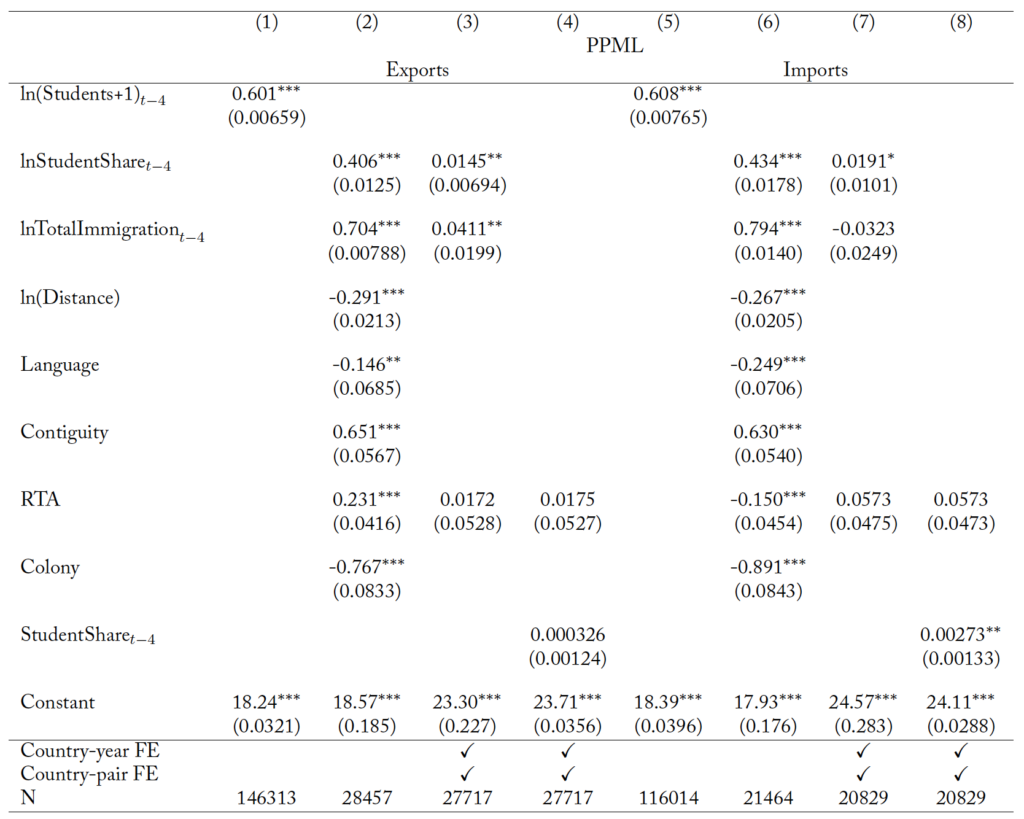
Standard errors clustered by country-pair in parentheses * p<0.10, ** p<0.05, *** p<0.01. When the student share is logged, the value one is added to the number of students before taking the logarithm.
A natural alternative explanation for this finding is that countries that trade more goods also trade more students. For one, I control for country-pair fixed effects and long-term connections between countries. Doing so reveals that the additional impact students have for exports is driven by bilateral and time invariant factors, rather than a reduction in information barriers. As for imports, the opposite applies. The higher the student share, the higher imports from the students’ origin to the host. For two, lagging explanatory variables cannot solve a reverse causality issue completely. Still, as Bellemare et al. (2017) argue, there are circumstances that justify their use. That is among others, when reverse causation and causal effect operate at different times. This is a testable assumption, and following Bellemare et al. (2017), I do so by regressing exports (or imports) on the lagged and contemporary student share.
Table 2 provides evidence that the impact a student share has on trade, both exports and imports, is not instant, but only manifests with a time lag. The crux of it is the assumption that although reverse causation may exist, the identified effect from on
occurs at a different time (see Figure 4). Without a contemporaneous effect from
on
, my estimate can thus still be causal (Bellemare et al., 2017).
Figure 4. Directed Acyclical Graph: Student Share and International Trade (Reverse Causation in Blue) Following Bellemare et al. (2017)
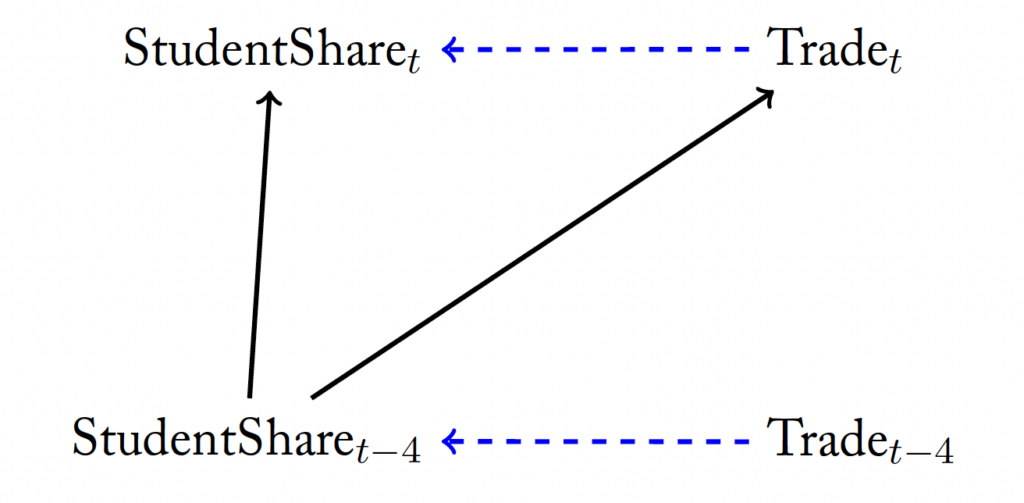
Clearly, Figure 4 does not provide a complete picture of all existing causal pathways. For estimated in Equation 2 to be causal, I need to assume that there are no unobserved confounders, which is a nearly untestable assumption. Essentially, this requires us to believe that
is an exogenous instrument for
. To test the idiosyncratic endogeneity of such an instrument, Lin and Wooldridge (2019) propose to include first-stage residuals in the estimating equation. This provides a statistical test for the shock exogeneity of the instrument. The results to this are in Appendix Table 13. An insignificant coefficient on the first-stage residual (or control function) suggests that one cannot reject that
is indeed exogenous to idiosyncratic shocks.16The test statistic is low at 0.12 (Column (2)) and -0.39 (Column (4)). Moreover, country-pair, destination-year and origin-year fixed effects control for heterogeneity confounding the estimate. With this in mind, I now turn to differing sources of information frictions to explore the information channel in more detail.
Table 2. Testing the Timing of the Estimated Impact Regarding Reverse Causality as in Bellemare et al. (2017)
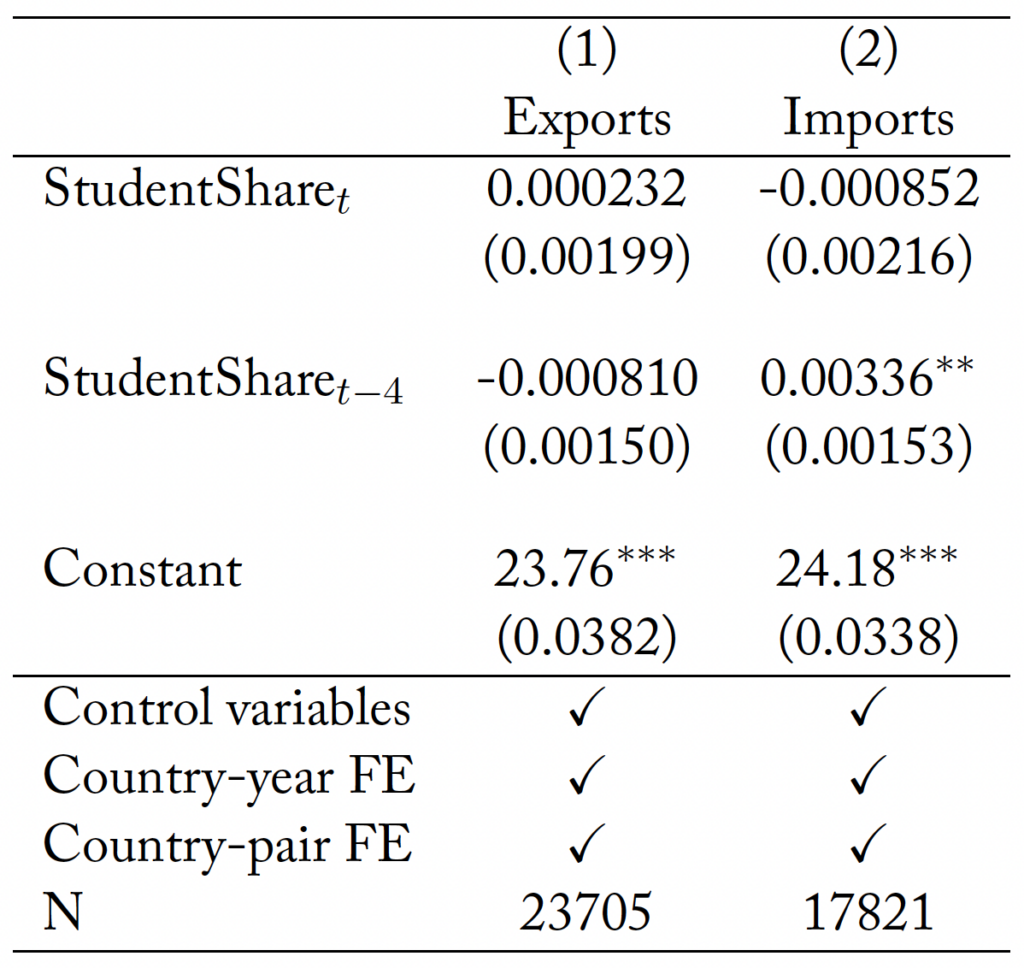
Standard errors clustered by country-pair in parentheses p<0.10, ** p<0.05, *** p<0.01.
4.2 Information frictions and international students
Although the above results point to the information channel, the specification used presumes that the relative importance of the preference and information channels is the same across countries and products. This, however, need not be the case and I explore this here.
Aggregate trade Previous literature suggests sharing a language, similar cultures and institutions reduces transaction costs that deter trade. As a result, immigrants can help to reduce those transaction costs with their worldly knowledge and contacts. This in turn leads to higher trade outcomes from migration when such barriers are large (Dunlevy, 2006; Girma and Yu, 2002). To examine this for international student migration, I first separate the origin countries into those with and without OECD membership.17OECD members are the 34 countries that joined the OECD by 2010. The Appendix provides a list of these countries (List of OECD member states (ISO 3166 alpha-3 code)). Notice that this list is not identical to that of host countries included. Since the hosts are essentially all OECD members, I expect the information barriers to be greater for the non-OECD origins and therefore a larger impact for immigrants and students from non-OECD countries. If found, this would mirror Bratti et al. (2014) who find a higher effect on Italian exports of immigration from low-income countries than from high-income ones.
With this in mind, Table 3 shows a difference in the effect of the share of international students by OECD membership for imports.18In the Appendix, Table 16 interacts the student share variable with OECD membership and achieves significance for exports. However, both coefficients have the same sign. Indeed, the student share does not seem to matter as much for host and origin institutional distance. Indeed, it is the opposite for exports. This result suggests that Girma and Yu’s (2002) conjectures on immigration and trade do not hold for international student migration. This then implies that the student share matters the most when information frictions are low. To continue deepening our knowledge behind an information channel, my analysis does not stop at this point.
Table 3. Cultural Dimension by OECD Membership
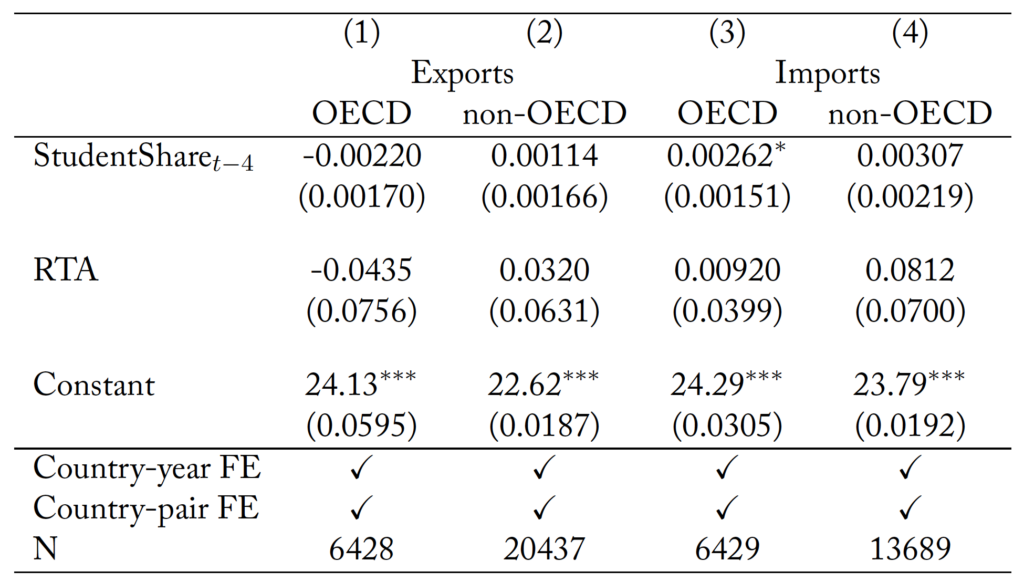
Standard errors clustered by country-pair in parentheses * p<0.10, ** p<0.05, *** p<0.01.
All destination countries are OECD members.
That is, as an alternate approach, I can use proxies for information barriers, namely, the geographical distance between trading partners, whether they share a common official language or have been in a colonial relationship, and interact them with the immigration variables. Table 4 shows these results for exports in Columns (1) through (3) and imports for Columns (4) through (6). In Columns (1) and (4) we see that distance increases the effect of the student share (although insignificantly for imports). The interaction with colony (Column (2) and Column (5)), contrary to expectations, has a positive coefficient, which suggests students matter more when information barriers are low.19This only holds for OECD OECD trade and not when the origin country is non-OECD, see Appendix Table 17. Note that within the OECD-OECD sample, all colonial relationships are with the UK. This suggests that, at least when discussing the particular role of international students, these may be weak proxies for cultural barriers.20An alternative rationale for the unexpected colony result is racism. If racial barriers are higher for immigrants from former colonial holdings, then the colony variable would be positively related to cultural barriers, rather than inversely as is commonly anticipated. If this were the case, I would expect a negative coefficient on the colony variable itself, which is what I find in Column (2). Finally, note that the lack of significance on the common language interaction with students differs from Murat (2014), who finds a negative coefficient in import regressions. It should be noted, however, that in her sample, the UK is the only host. Given that even in the raw data there is an attraction to English-speaking hosts, this may be the result of some other factor driving student migration that I can control for by using a broader set of hosts.
Product-level trade Information frictions can be more costly for some goods than others: the more differentiated the good, the more information is necessary to trade it (Rauch, 1999).
Table 4. Cultural Dimension: Culture Interactions
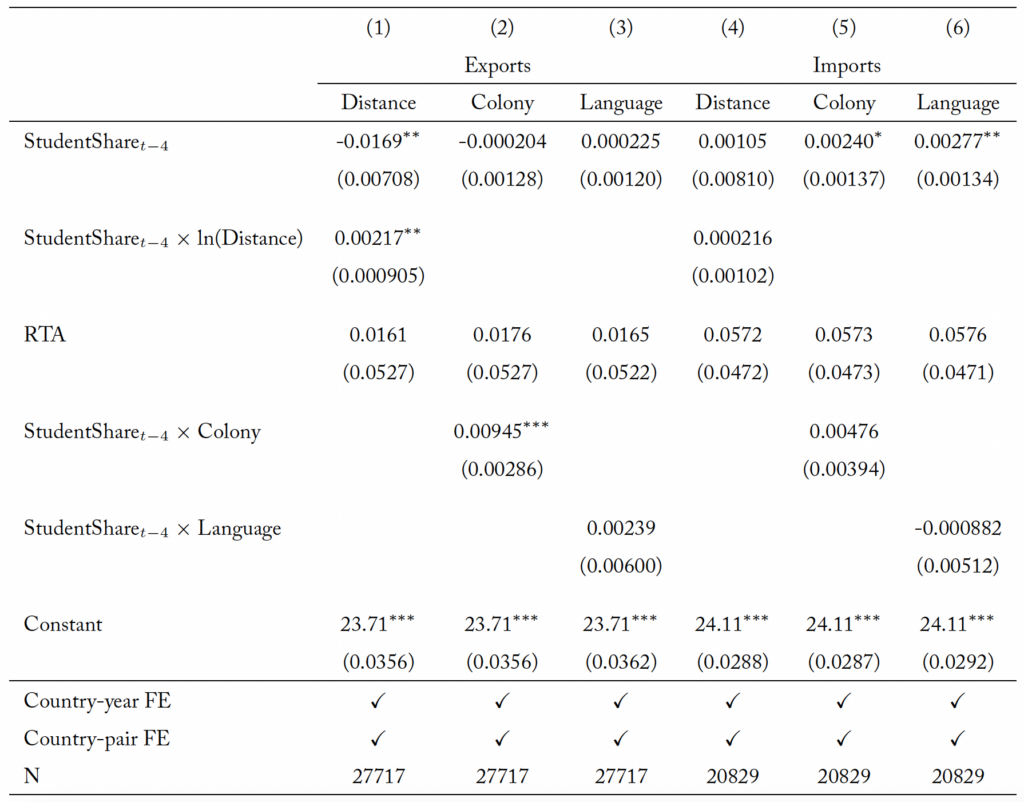
Standard errors clustered by country-pair in parentheses * p<0.10, ** p<0.05, *** p<0.01.
Table 5 shows product-level trade disaggregated at the HS96 6-digit level, splitting the sample into goods traded on an organised exchange, reference priced, or differentiated based on Rauch’s (1999) classification. Again, I investigate the effects on exports and imports separately. Beginning with exports (Columns (1)–(3)), the international student share seems to significantly increase the association that immigrants have with products traded on an organized exchange. Surprisingly, the coefficient for differentiated products turns negative and significant. Turning to imports (Columns (4)–(5)), the student share coefficient is insignificant throughout all differentiation levels. Thus, contrary to Table 1, the results suggest that the preference channel dominates.
As for the margin at which migration affects trade, Hatzigeorgiou and Lodefalk (2015) find that the extensive margin is the dominant one—and even more so for differentiated products trade. This is in light of the fact that trade at this margin reacts more strongly to fixed costs (Anderssonab, 2007; Chaney, 2008). I examine whether the same holds for international student migration in Table 6. I measure the extensive and intensive margins following Hatzigeorgiou and Lodefalk (2015) as the total number of traded products and the average value per traded product, respectively. Yet, international students are associated with an increase in exports and imports only at the intensive margin. Indeed, students have the ability to bridge informational frictions and promote imports. This ability, however, is not as great as it can induce trade in never traded products but it can strengthen existing goods trade.
That said, in Table 3 I found heterogeneous results after splitting the sample into OECD and non-OECD origins. With this in mind, Table 5 repeats this product decomposition but for just the OECD origins (the middle panel) and non-OECD origins (the bottom panel). For OECD origins, I find that students matter the most for exports in organized exchange and reference priced products. As to which channel is responsible for this, for exports, it is both the preference and the information channel. In contrast, for non-OECD origins, they matter more for differentiated imports. Thus, students seem to increase trade in the least differentiated products when informational barriers are low (OECD-OECD) and increase trade among more differentiated products when they are high (non-OECD-OECD). A potential explanation for this difference could be the role of experience in the two origin groups. In OECD origin countries, recent graduates may be most influential in the least-differentiated goods, that is, while they might work in a differentiated products industry, they lack the experience to influence with whom their company trades. In a non-OECD country, because these recent graduates are much more skilled than the local average, they may reach these positions more swiftly.
This latter matches expectations, that is, students help to overcome informational barriers when they are high at both the country- and product-level. This suggests an important relationship between country-level barriers and product-specific ones when considering the role of student migration in trade.
Table 5. Product Differentiation
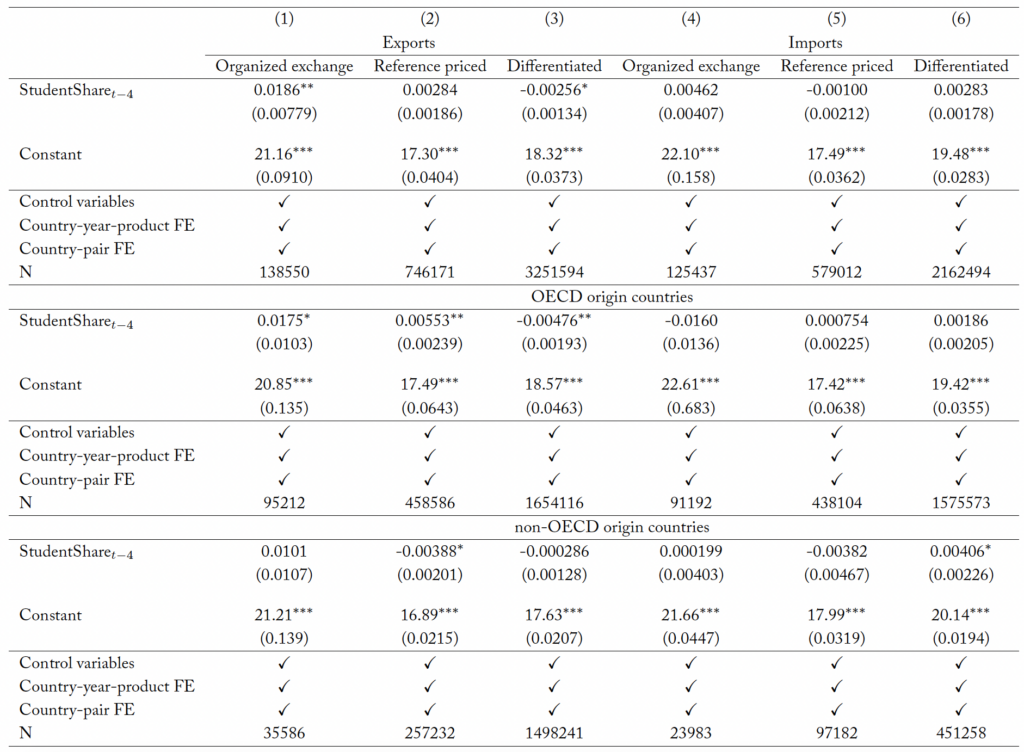
Standard errors clustered by country-pair in parentheses * p<0.10, ** p<0.05, *** p<0.01. All destination countries are OECD members when sample is split by origin OECD membership.
Table 6. Product Differentiation by Margin
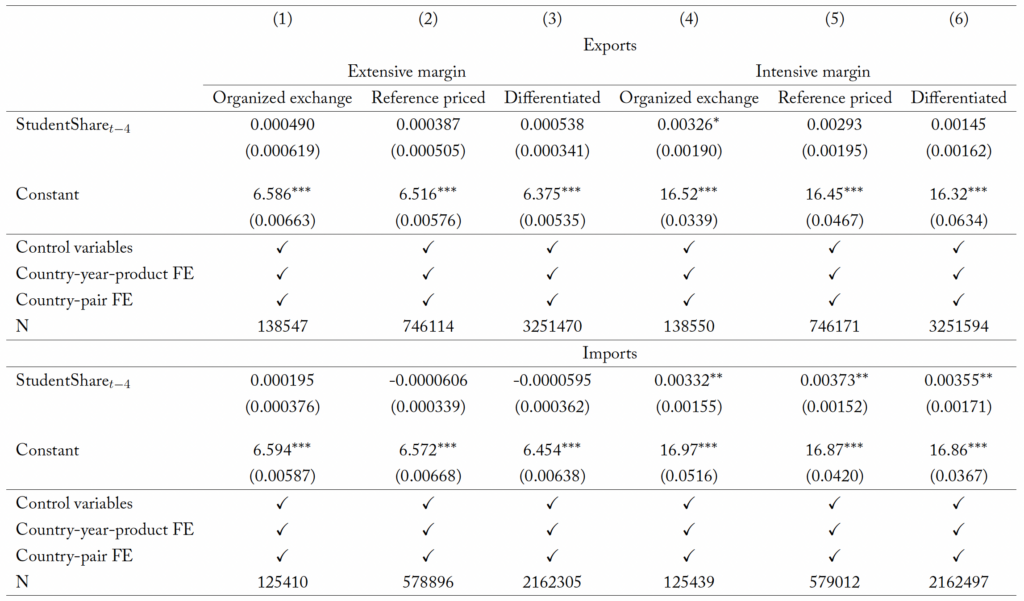
Standard errors clustered by country-pair in parentheses * p<0.10, ** p<0.05, *** p<0.01.
Finally, in Table 7 I use Nunn’s (2007) relationship-specificity (also contract intensity) measure as an alternative indicator of differentiation. In this classification, high relationship-specific goods require business relationships and contracts for many of their inputs. While national institutional quality boosts international trade, business collectives can help overcome information asymmetries in the absence of operating institutions (Greif, 1993). If networks between international students and the host country provide market information and business trust, this should strengthen trade, particularly in contract-intensive goods.
To explore this, Table 7 splits the sample into high (above median) and low contract-intensive goods exports and imports similar to Egger et al. (2019). This results in coefficients where the strongest effect is for exports, most clearly for the low contract-intensity goods, contrary to the expected. Yet, a tendency as with Rauch’s (1999) classification is still apparent. Moreover, when interacting contract intensity with the student share, this association even turns negative for imports (Appendix, Table 18). However, to preview at which margin a trade effect takes place, both less and high contract-intensive goods are imported in higher volumes the higher the student share.
As above, there may be reasons to expect differences between OECD and non-OECD origins. In particular, countries with good legal institutions and contract enforcement (OECD) may have relatively small trust issues for students to overcome (Anderson and Marcouiller, 2002; Beverelli et al., 2018). I therefore again split the sample across origin groups. Doing this reveals two things. First, there is no difference between students and the average migrant for imports between contract intensities and origins. Second, within the OECD, a higher student share boosts exports in less contract-intensive exports while it hampers those at high intensity, something that matches the observation made in Table 5.
Again, to find the margin at which contract-intensity matters, Table 8 splits exports and imports into its extensive and intensive margin dimensions. Once more, I find impacts along the intensive margin. As mentioned above, students seem to have limited means to initiate a product’s trade. Still, they can form links with countries that are so strong that they can reduce the risk of trade and boost it intensively.
Table 7. Contract Intensity
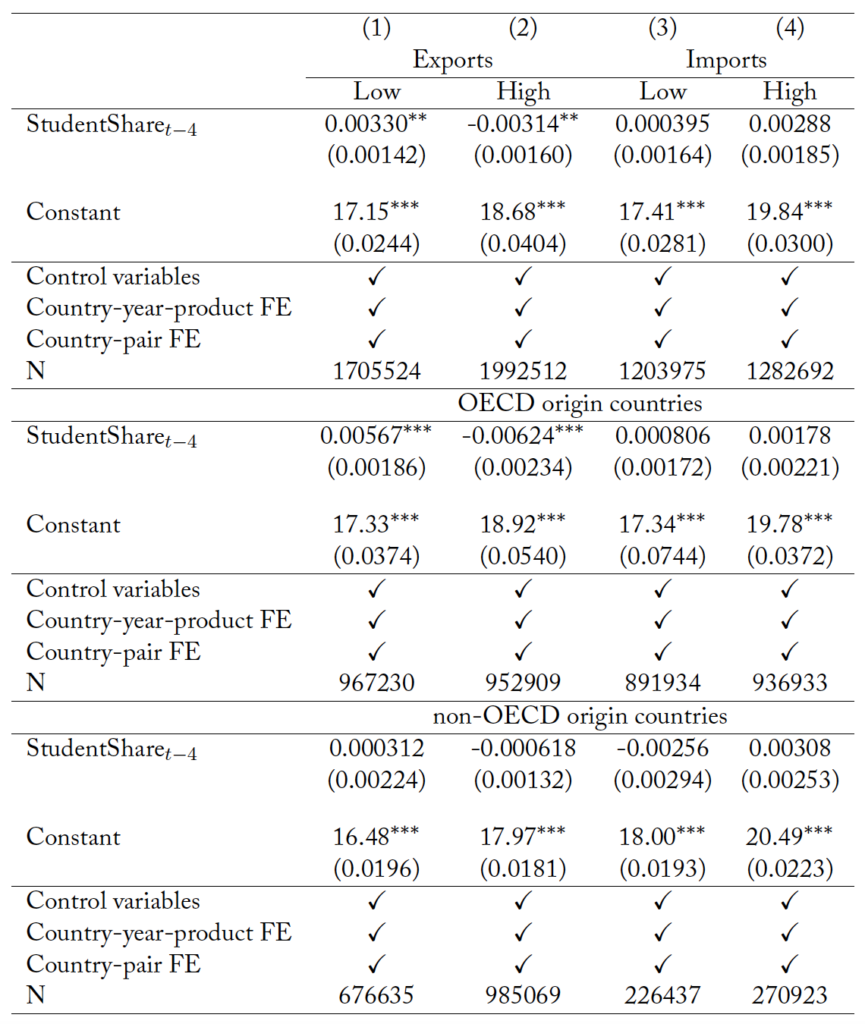
Standard errors clustered by country-pair in parentheses * p<0.10, ** p<0.05, *** p<0.01. All destination countries are OECD members when sample is split by origin OECD membership.
Table 8. Contract Intensity by Margin
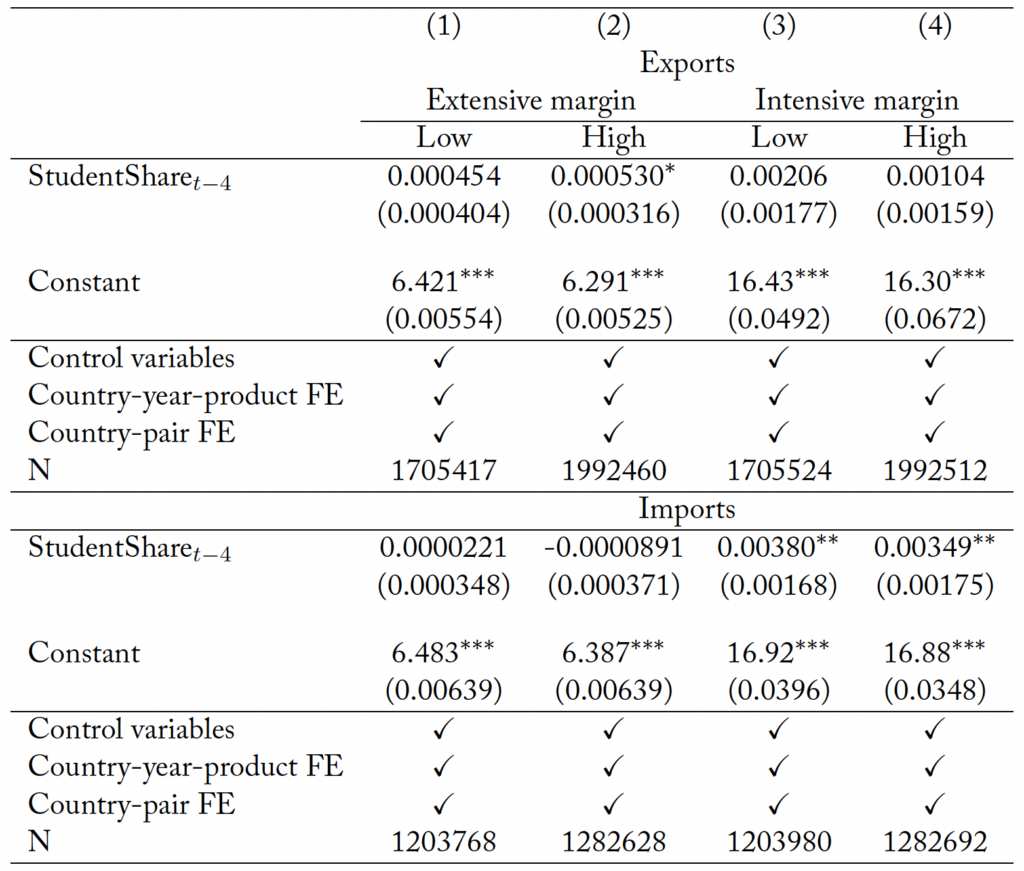
Standard errors clustered by country-pair in parentheses * p<0.10, ** p<0.05, *** p<0.01.
5 Conclusion
There is now a large body of evidence suggesting that immigration increases trade. Increasingly, focus has been given to the composition of those migrants by comparing high-skill migrants to others. One type of high-skill migrant not often discussed is the international exchange student. The temporary nature of their stay provides a useful example to separate the two main drivers of the immigrant-trade link: the preference channel and the information channel. Overall, I find that international students have a larger than average association with trade. Assuming the (student) preference channel to operate through exports from host to origin, I find evidence that its relevance depends on the existing relationship between both parties. Once controlled for, the information channel takes over.
Moreover, the student’s origin determines the impact they have on trade. I notice a relationship with trade—especially for students from geographically distant countries where informational barriers may be most severe. This is reinforced by findings that indicate that students from these countries most affect products for which issues of information and trust are major. In contrast, students from OECD origins seem to play little role in overcoming information barriers, but rather impact trade the most in less-differentiated products. This may result from the time it takes to reach a position of influence in these products.
From a policy perspective, these results suggest that one way to encourage trade growth with developing countries is to provide funding and support that increases international student exchange. Additionally, if experience plays a role, then providing international students with internships and other hands-on opportunities may help origin countries upgrade their export product basket or better connect them to global supply chains via imported intermediates. Policies in this direction might include allowing students to be employed as part of their student visas or giving students the opportunity to extend their visas after graduation. This can further help host countries to attract international talent while boosting human capital in the origin via returning students (Haupt et al., 2014).
The goal of this paper has been to provide a close investigation of the relationship between international student migration and trade across a broad set of countries and products. Doing so shows that the type of immigrant and their origin matters in their ability to promote trade in general and specific products in particular. Therefore, it is up to future research to continue studying the mechanisms through which individual immigrant networks transmit information, and in doing so, take into account the differences between immigrants.
6 Appendix
Figure 5. Data Truncation from 2018: Total Student Number (in Thousands) Based on the Number of International Students from UNESCO (2020)
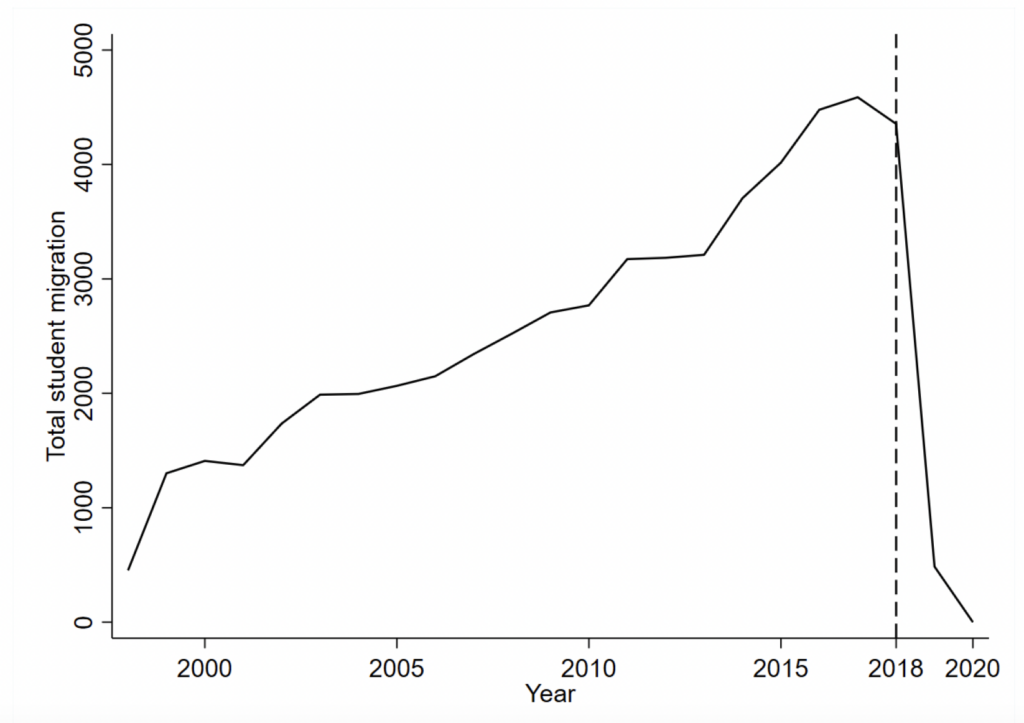
Table 9. List of Top 5 Host Countries
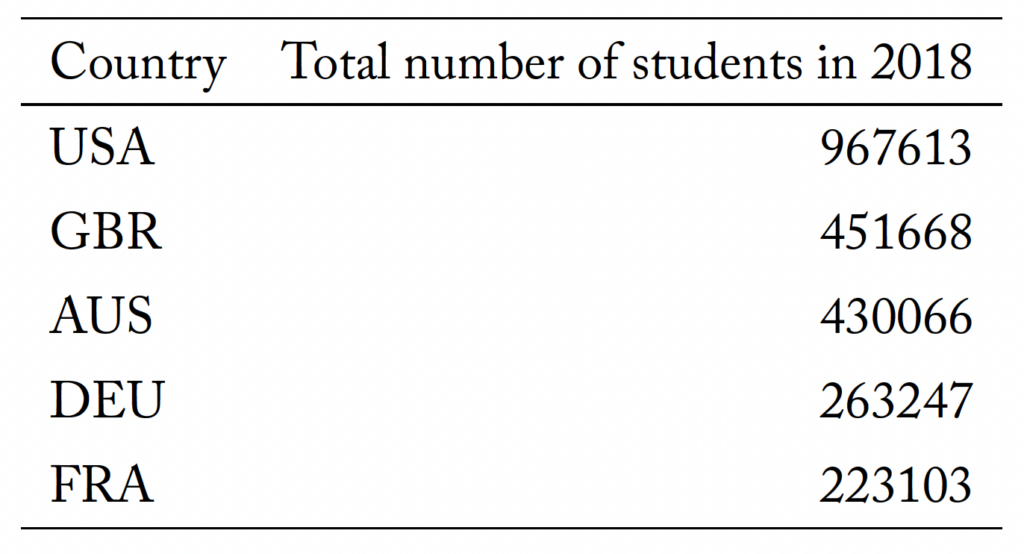
Mapping trade classifications To merge UN COMTRADE’s HS96 6-digit trade data with Rauch and Trindade’s (2002) and Nunn’s (2007) measures, I converted HS96 6-digit data into SITC2 4-digit and ISIC Rev. 2 utilising UN Statistics Division’s Classifications on economic statistics tables (https://unstats.un.org/unsd/classifications/Econ) and World Integrated Trade Solution (WITS)’s Product Concordance (https://wits.worldbank.org/product_concordance.html).
List of all origin countries (ISO 3166 alpha-3 code) AFG, AGO, ALB, AND, ARE, ARG, ARM, ATG, AUS, AUT, AZE, BDI, BEN, BFA, BGD, BGR, BHR, BHS, BIH, BLR, BLZ, BMU, BOL, BRA, BRB, BRN, BTN, CAF, CAN, CHE, CHL, CHN, CMR, COG, COK, COL, COM, CPV, CRI, CUB, CYP, CZE, DEU, DJI, DMA, DNK, DOM, DZA, ECU, EGY, ERI, ESP, EST, FIN, FJI, FRA, FSM, GAB, GBR, GEO, GHA, GIN, GMB, GNB, GRC, GRD, GTM, GUY, HKG, HND, HRV, HTI, HUN, IDN, IND, IRL, IRN, IRQ, ISL, ISR, ITA, JAM, JOR, JPN, KAZ, KEN, KGZ, KHM, KIR, KNA, KOR, KWT, LAO, LBN, LBR, LBY, LCA, LKA, LTU, LVA, MAR, MDA, MDG, MEX, MHL, MLI, MLT, MOZ, MRT, MUS, MWI, MYS, NER, NGA, NIC, NIU, NLD, NOR, NPL, NRU, NZL, OMN, PAK, PAN, PER, PHL, PLW, PNG, POL, PRT, PRY, QAT, RUS, RWA, SAU, SEN, SGP, SLB, SLE, SLV, SOM, STP, SUR, SVK, SVN, SWE, SYC, SYR, TCD, TGO, THA, TJK, TKM, TON, TTO, TUN, TUR, TUV, TZA, UGA, UKR, URY, USA, UZB, VCT, VEN, VNM, VUT, YEM, ZAF, ZMB, ZWE
List of all host countries (ISO 3166 alpha-3 code) AUS, AUT, BGR, CAN, CHE, CHL, CZE, DEU, DNK, ESP, EST, FIN, FRA, GBR, GRC, HUN, IRL, ISL, ISR, ITA, LTU, LVA, MEX, NLD, NOR, NZL, POL, PRT, RUS, SVK, SVN, SWE, TUR, USA
List of OECD member states (ISO 3166 alpha-3 code) AUS, AUT, BEL, CAN, CHE, CHL, CZE, DEU, DNK, ESP, EST, FIN, FRA, GBR, GRC, HUN, ISL, IRL, ISR, ITA, JPN, KOR, LUX, MEX, NLD, NOR, NZL, POL, PRT, SVK, SVN, SWE, TUR, USA
Table 10. Baseline Regression: OLS
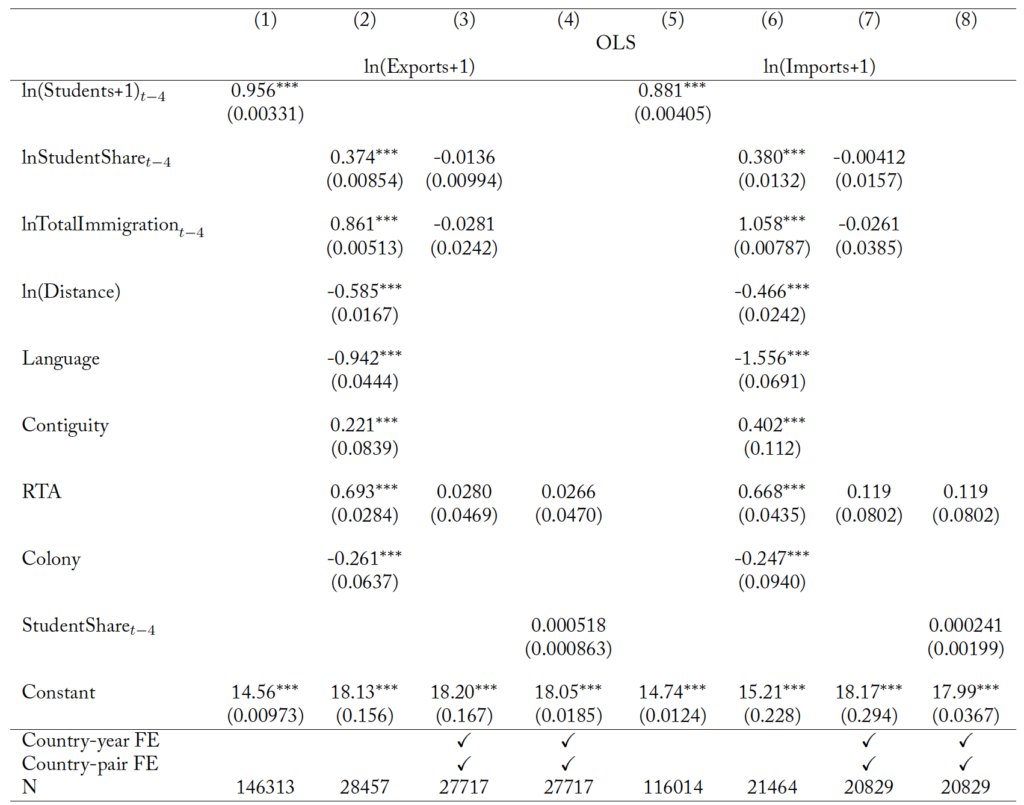
Standard errors clustered by country-pair in parentheses * p<0.10, ** p<0.05, *** p<0.01. When the student share is logged, the value one is added to the number of students before taking the logarithm.
Table 11. Specification Robustness: Exports
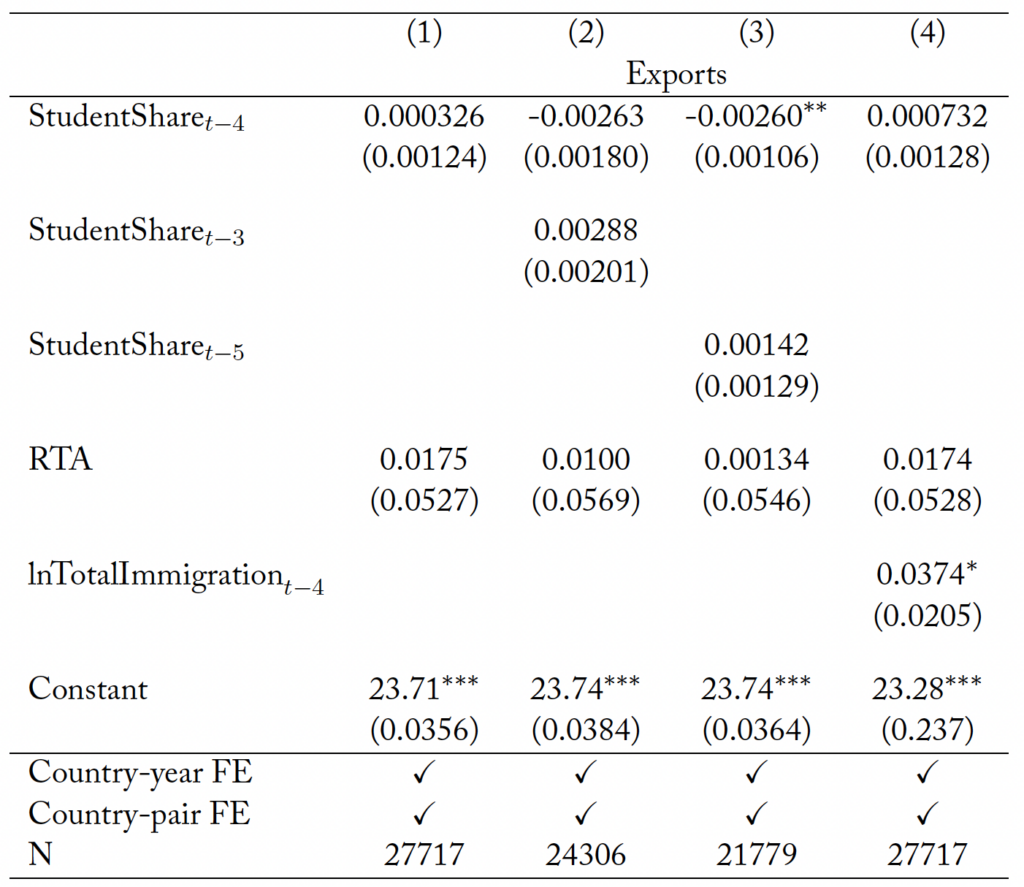
Standard errors clustered by country-pair in parentheses * p<0.10, ** p<0.05, *** p<0.01.
Table 12. Specification Robustness: Imports
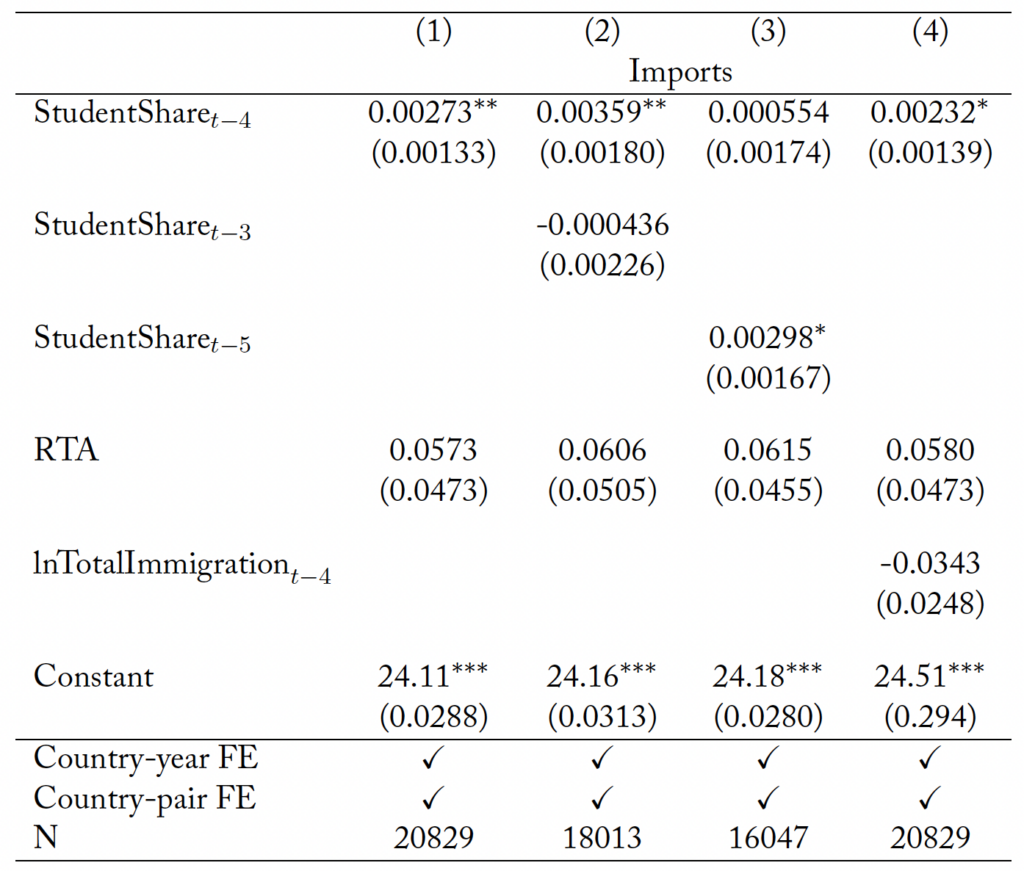
Standard errors clustered by country-pair in parentheses * p<0.10, ** p<0.05, *** p<0.01.
Table 13. Control Function Approach (Lin and Wooldridge, 2019)

Standard errors clustered by country-pair in parentheses * p<0.10, ** p<0.05, *** p<0.01.
Table 14. Education-level Comparison
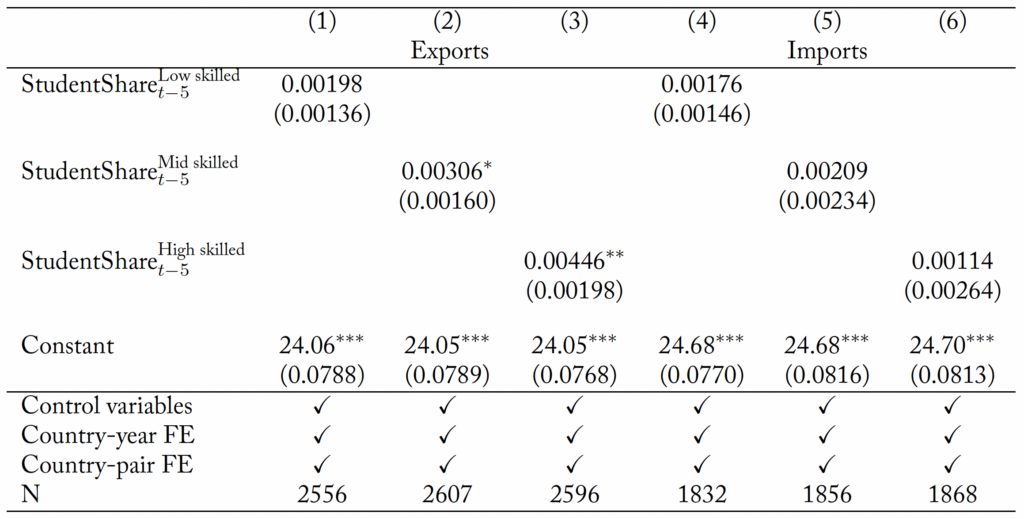
Standard errors clustered by country-pair in parentheses * p<0.10, ** p<0.05, *** p<0.01. Data on immigrants by skill level are from OECD (2023) and only available every five years. The student share is taken from the sum of the student number and the respective number of immigrants in a category.
Table 15. Summary Statistics
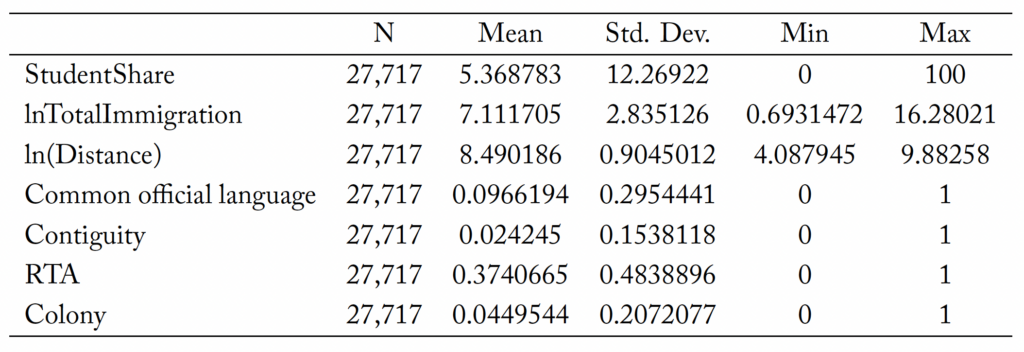
Table 16. Cultural Dimension by OECD Membership: Interaction
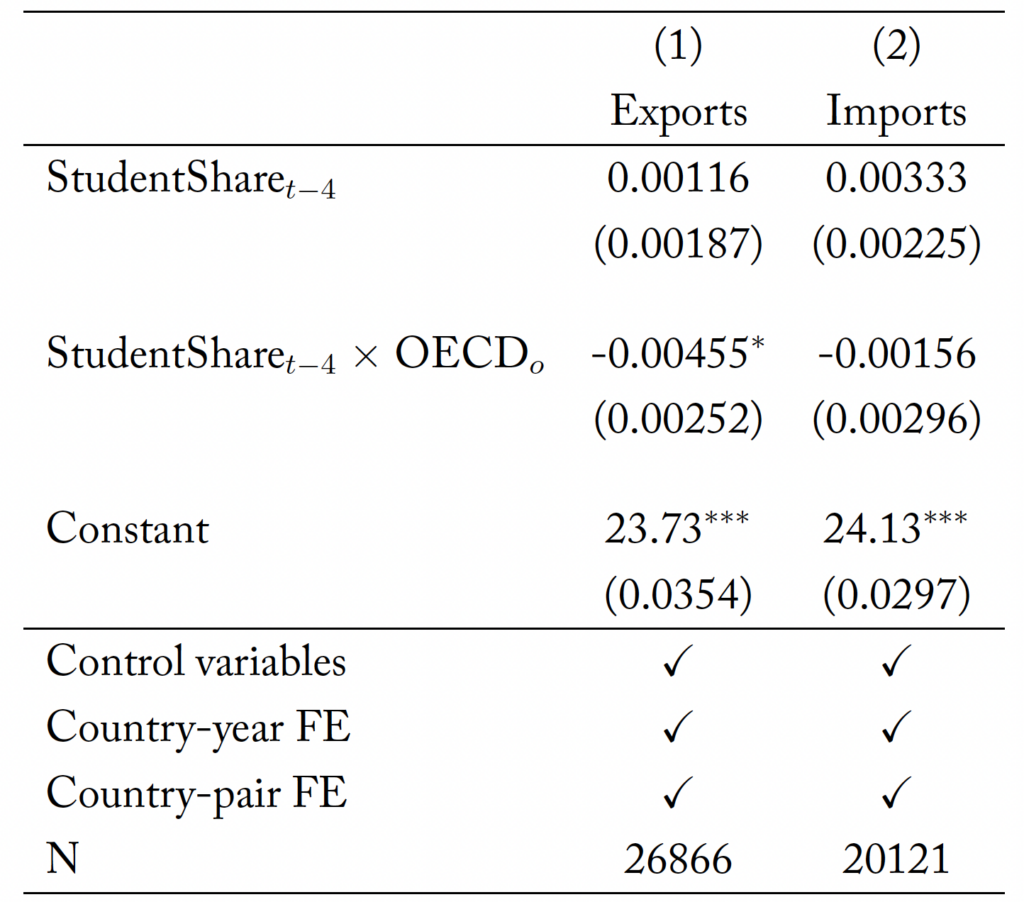
Standard errors clustered by country-pair in parentheses * p<0.10, ** p<0.05, *** p<0.01. All destination countries are OECD members.
Table 17. Cultural Dimension: Culture Interactions by OECD Membership
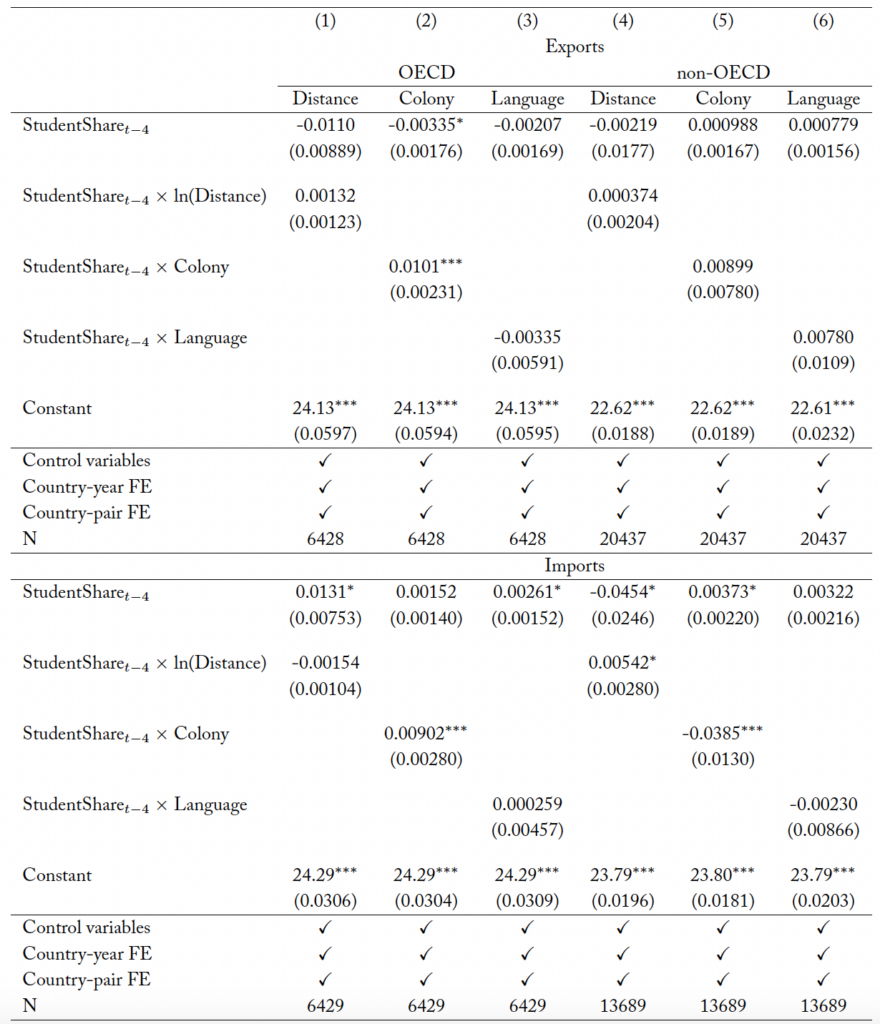
Standard errors clustered by country-pair in parentheses * p<0.10, ** p<0.05, *** p<0.01. All destination countries are OECD members.
Table 18. Contract Intensity: Interaction
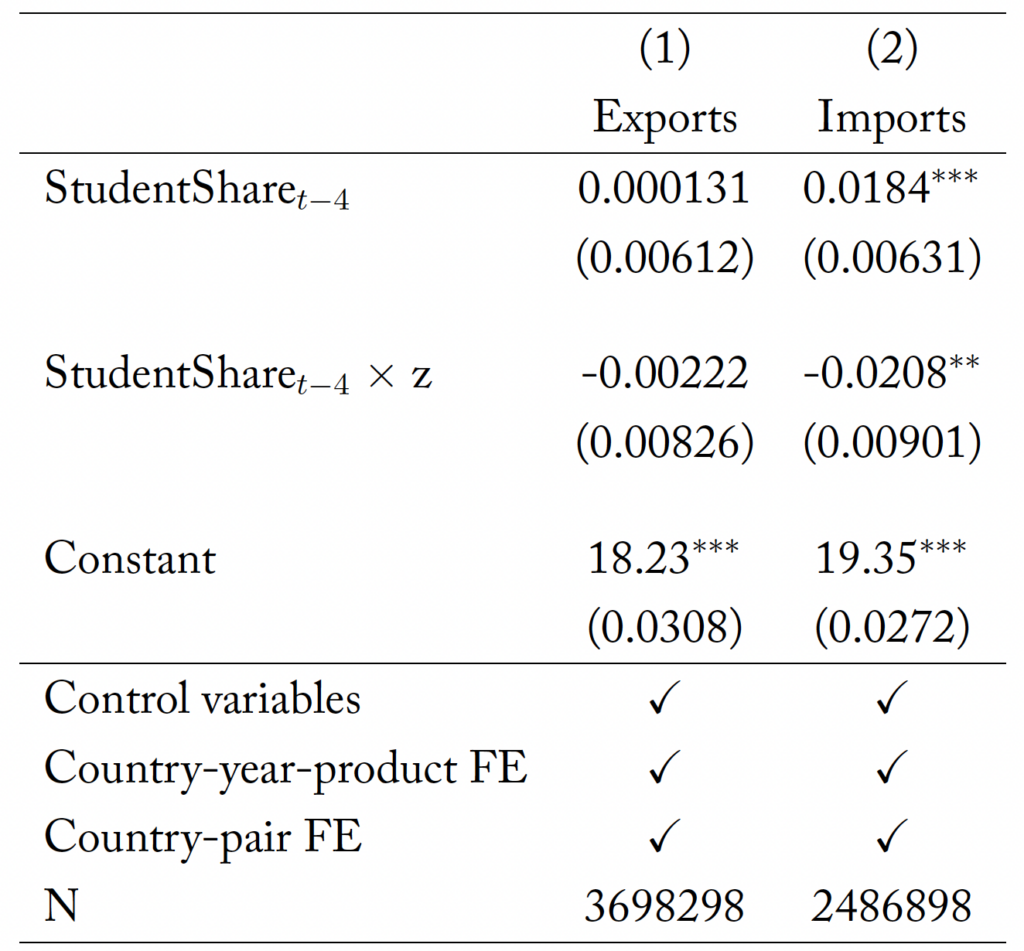
Standard errors clustered by country-pair in parentheses * p<0.10, ** p<0.05, *** p<0.01.
References
Aleksynska, Mariya and Giovanni Peri, “Isolating the network effect of immigrants on trade,” The World Economy, 2014, 37 (3), 434–455.
Anders, George, “Hiring’s new red line: why newcomers can’t land 35% of “entry-level” jobs,” https://www.linkedin.com/pulse/hirings-new-red-line-why-newcomers-cant-land-35-jobs-george-anders/. Accessed: 19/06/2023 2021. Accessed on 19/06/2023.
Anderson, James E and Douglas Marcouiller, “Insecurity and the pattern of trade: An empirical investigation,” Review of Economics and Statistics, 2002, 84 (2), 342–352.
and Eric Van Wincoop, “Gravity with Gravitas: A Solution to the Border Puzzle,” American Economic Review, 2003, 93 (1), 170–192.
and — , “Trade Costs,” Journal of Economic Literature, 2004, 42 (3), 691–751.
Anderssonab, Martin, “Entry Costs and Adjustments on the Extensive Margin –An Analysis of How Familiarity Breeds Exports,” CESIS Working Paper 81. Royal Institute of Technology, Stockholm, 2007.
Angrist, Joshua D. and Jörn-Steffen Pischke, Mostly Harmless Econometrics: An Empiricist’s Companion, Princeton University Press, 2009.
Bailey, Michael, Abhinav Gupta, Sebastian Hillenbrand, Theresa Kuchler, Robert Richmond, and Johannes Stroebel, “International trade and social connectedness,” Journal of International Economics, 2021, 129, 103418.
Beine, Michel, Simone Bertoli, and Jesús Fernández-Huertas Moraga, “A practitioners’ guide to gravity models of international migration,” The World Economy, 2016, 39 (4), 496–512.
Bellemare, Marc F, Takaaki Masaki, and Thomas B Pepinsky, “Lagged explanatory variables and the estimation of causal effect,” The Journal of Politics, 2017, 79 (3), 949–963.
Beverelli, Cosimo, Alexander Keck, Mario Larch, and Yoto V Yotov, “Institutions, trade and development: A quantitative analysis,” CESifo Working Paper Series, 2018.
Bratti, Massimiliano, Luca De Benedictis, and Gianluca Santoni, “On the pro-trade effects of immigrants,” Review of World Economics, 2014, 150 (3), 557–594.
Carballo, Jerónimo, Marisol Rodriguez Chatruc, Catalina Salas Santa, and Christian Volpe Martincus, “Online business platforms and international trade,” Journal of International Economics, 2022, 137, 103599.
Chaney, Thomas, “Distorted gravity: the intensive and extensive margins of international trade,” American Economic Review, 2008, 98 (4), 1707–21.
Cohen, Lauren, Andrea Frazzini, and Christopher Malloy, “The small world of investing: Board connections and mutual fund returns,” Journal of Political Economy, 2008, 116 (5), 951–979.
Correia, Sergio, Paulo Guimarães, and Thomas Zylkin, “Verifying the existence of maximum likelihood estimates for generalized linear models,” 2019.
–, — , and — , “Fast Poisson estimation with high-dimensional fixed effects,” The Stata Journal, 2020, 20 (1), 95–115.
Dunlevy, James A, “The influence of corruption and language on the protrade effect of immigrants: Evidence from the American States,” Review of Economics and Statistics, 2006, 88 (1), 182–186.
Egger, Peter and Mario Larch, “Interdependent preferential trade agreement memberships: An empirical analysis,” Journal of International Economics, 2008, 76 (2), 384–399.
Egger, Peter H, Katharina Erhardt, and Andrea Lassmann, “Immigration and firms’integration in international production networks,” European Economic Review, 2019, 111, 1–34.
— , Maximilian v Ehrlich, and Douglas R Nelson, “The trade effects of skilled versus unskilled migration,” Journal of Comparative Economics, 2020, 48 (2), 448–464.
Felbermayr, Gabriel J and Benjamin Jung, “The pro-trade effect of the brain drain: Sorting out confounding factors,” Economics Letters, 2009, 104 (2), 72–75.
— and Farid Toubal, “Revisiting the trade-migration nexus: Evidence from new OECD data,” World Development, 2012, 40 (5), 928–937.
Girma, Sourafel and Zhihao Yu, “The link between immigration and trade: Evidence from the United Kingdom,” Weltwirtschaftliches Archiv, 2002, 138 (1), 115–130.
Gould, David M, “Immigrant Links to the Home Country: Empirical Implications for U.S. Bilateral Trade Flows,” The Review of Economics and Statistics, 1994, pp. 302–316.
Greif, Avner, “Reputation and Coalitions in Medieval Trade: Evidence on the Maghribi Traders,” The Journal of Economic History, 1989, 49 (4), 857–882.
— , “Contract enforceability and economic institutions in early trade: The Maghribi traders’ coalition,” American Economic Review, 1993, pp. 525–548.
Hatzigeorgiou, Andreas and Magnus Lodefalk, “Trade, migration and integration–evidence and policy implications,” The World Economy, 2015, 38 (12), 2013–2048.
Haupt, Alexander, Tim Krieger, and Thomas Lange, “Education Policy, Student Migration, and Brain Gain,” in “The Mobility of Students and the Highly Skilled: Implications for Education Financing and Economic Policy,” The MIT Press, 12 2014.
Head, Keith and John Ries, “Immigration and Trade Creation: Econometric Evidence from Canada,” Canadian Journal of Economics, 1998, pp. 47–62.
Herander, Mark G and Luz A Saavedra, “Exports and the Structure of Immigrant-Based Networks: The Role of Geographic Proximity,” Review of Economics and Statistics, 2005, 87 (2), 323–335.
Jansen, Marion and Roberta Piermartini, “Temporary migration and bilateral trade flows,” World Economy, 2009, 32 (5), 735–753.
Khan, Yasir and Qiu Bin, “Does student mobility affect trade flows? New evidence from Chinese provinces,” The Singapore Economic Review, 2022, 67 (03), 1089–1116.
King, Russell and Enric Ruiz-Gelices, “International Student Migration and the European ‘Year Abroad’: Effects on European Identity and Subsequent Migration Behaviour,” International Journal of Population Geography, 2003, 9 (3), 229–252.
Lin, Wei and Jeffrey M. Wooldridge, “Chapter 2 – Testing and Correcting for Endogeneity in Nonlinear Unobserved Effects Models,” in Mike Tsionas, ed., Panel Data Econometrics, Academic Press, 2019, pp. 21–43.
Machado, Cecilia, Germán Reyes, and Evan Riehl, “Alumni job networks at elite universities and the efficacy of affirmative action,” IZA Discussion Paper, 2022.
Mayer, Thierry and Soledad Zignago, “Notes on CEPII’s distances measures: The GeoDist database,” Working Papers 2011-25, CEPII 2011. http://www.cepii.fr/CEPII/en/publications/wp/abstract.asp?NoDoc=3877.
Melitz, Jacques and Farid Toubal, “Native language, spoken language, translation and trade,” Journal of International Economics, 2014, 93 (2), 351–363.
Mion, Giordano and Luca David Opromolla, “Managers’ mobility, trade performance, and wages,” Journal of International Economics, 2014, 94 (1), 85–101.
Munoz, Jesus Escriva, Benjamin Helm, Adriana Perez Encinas, Jurgita Stasiukaityte, and Bojana Zimonjic, “ESN survey 2015: Local Integration, Economic Impact and Accompanying Measures in International Mobility,” Erasmus Student Network AISBL, 2015.
Murat, Marina, “Out of sight, not out of mind. Education networks and international trade,” World Development, 2014, 58, 53–66.
— , “Foreign education and international trade: empirical evidence from selected Latin American countries,” International Review of Applied Economics, 2018, 32 (1), 84–103.
Nunn, Nathan, “Relationship-specificity, incomplete contracts, and the pattern of trade,” The Quarterly Journal of Economics, 2007, 122 (2), 569–600.
OECD, International Migration Outlook 2011, OECD Publishing, Paris, 2011. https://doi.org/10.1787/migr_outlook-2011-en.
OECD, “International Migration Database,” https://stats.oecd.org/Index.aspx?DataSetCode=MIG 2020. Date of extraction: 24/09/2020.
OECD, International Migration Outlook 2022, OECD Publishing, Paris, 2022. https://doi.org/10.1787/30fe16d2-en.
OECD, “Database on Immigrants in OECD Countries (DIOC),” https://www.oecd.org/els/mig/dioc.htm 2023. Date of extraction: July 2023.
Perkins, Richard and Eric Neumayer, “Geographies of educational mobilities: Exploring the uneven flows of international students,” The Geographical Journal, 2014, 180 (3), 246–259.
Rauch, James E, “Networks versus markets in international trade,” Journal of International Economics, 1999, 48 (1), 7–35.
— and Vitor Trindade, “Ethnic Chinese networks in international trade,” Review of Economics and Statistics, 2002, 84 (1), 116–130.
Santana-Gallego, María, Francisco J Ledesma-Rodríguez, and Jorge V Pérez-Rodríguez, “International trade and tourism flows: An extension of the gravity model,” Economic Modelling, 2016, 52, 1026–1033.
Silva, JMC Santos and Silvana Tenreyro, “The log of gravity,” The Review of Economics and Statistics, 2006, 88 (4), 641–658.
Startz, Meredith, “The value of face-to-face: Search and contracting problems in Nigerian trade,” Available at SSRN 3096685, 2016.
The World Bank, “World Development Indicators: (1) United Nations Population Division. World Population Prospects: 2019 Revision. (2) Census reports and other statistical publications from national statistical offices, (3) Eurostat: Demographic Statistics, (4) United Nations Statistical Division. Population and Vital Statistics Reprot (various years), (5) U.S. Census Bureau: International Database, and (6) Secretariat of the Pacific Community: Statistics and Demography Programme.,” https://databank.worldbank.org/reports.aspx?source=World-Development-Indicators 2021. Date of extraction: 17/02/2020.
UN, “Comtrade Database,” https://comtrade.un.org/ 2020.
UNESCO Institute for Statistics, “UIS Glossary,” https://glossary.uis.unesco.org/glossary/en/home n.d. Accessed on 19/6/23.
UNESCO Institute for Statistics (UIS), http://data.uis.unesco.org/ 2020. Date of extraction: 23/10/2020.
Wang, Zheng, Feicheng Wang, and Zhuo Zhou, “All Roads lead to Rome: Global Air Connectivity and Bilateral Trade,” 2021. Available at SSRN: https://ssrn.com/abstract=3884374 or http://dx.doi.org/10.2139/ssrn.3884374.
Wei, Hao, Ran Yuan, and Hang Su, “International Talent Mobility and China’s Consumer Goods Export: An Empirical Evidence from International Student” / “国际人才流动对中国消费品出口影响的实证分析, 国际贸易问题,” 国际贸易问题, 2020, (10).


 Poets & Quants
Poets & Quants